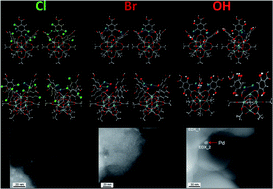How to functionalise metal–organic frameworks to enable guest nanocluster embedment†
Abstract
We report on the development and verification of an enhanced computational model capable of robust predictions and yielding a single descriptor to the successful embedding of guest nanoclusters into the pores of functionalised metal–organic frameworks. Using the predictions of this model, we have been able to embed Pd nanoclusters in the pores of Br-UiO-66 and show that the embedding of Pd nanoclusters in both (OH)2-UiO-66 and (Cl)2-UiO-66 is not successful. Also, using various independent methods, we identified the strong host–guest interactions that anchor the guest nanoclusters inside the Br-UiO-66 framework which result in the surface modification of said nanoclusters. We demonstrated that the level of this surface modification is a direct function of the framework functional groups. This new approach for the rational design of nanocluster–metal–organic framework systems, and a demonstrated tool box for their characterisation, will promote the exploitation of surface modification of nanoclusters via their embedding into functionalised metal–organic framework pores.



 Please wait while we load your content...
Please wait while we load your content...